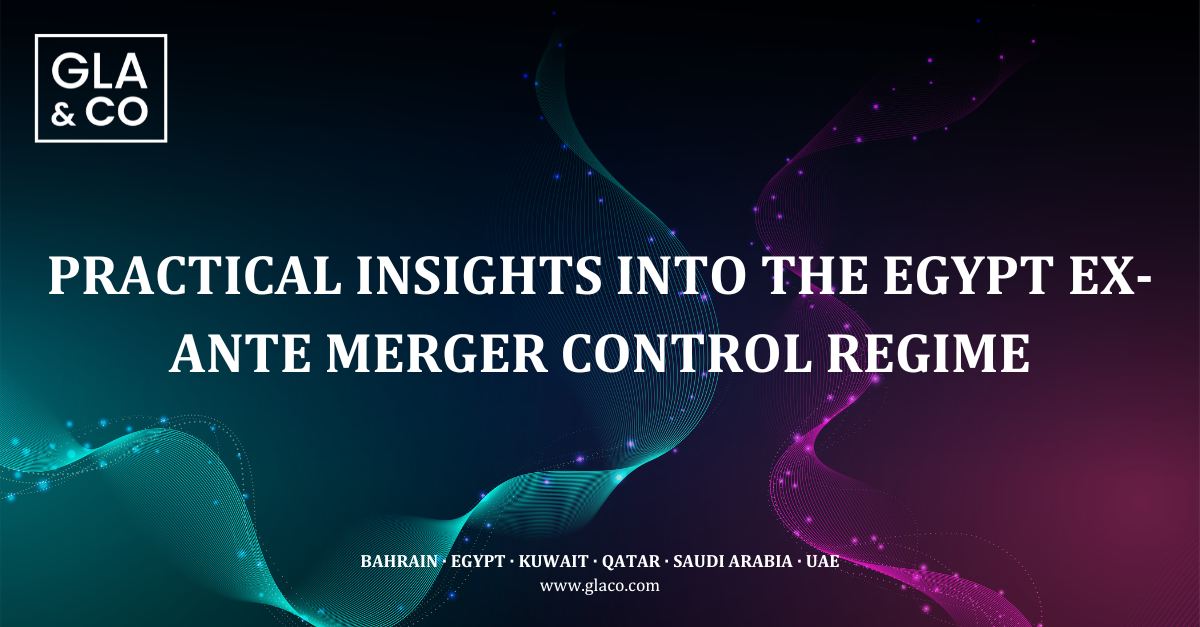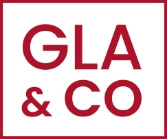
PRACTICAL INSIGHTS INTO THE EGYPT EX-ANTE MERGER CONTROL REGIME AND THE MOST RECENT ROUNTABLE DISCUSSIONS HELD BY THE REGULTOR
INTRODUCTION:
On 26 May 2024, the Egyptian ex-ante (pre-approval) merger control regime was substantiated with updated filing forms and a visualised infographic that serves as a practice guide to ensure an informed kick-off of the long awaited merger control regime. These changes are due to the amendments to the Egyptian Competition Law no. 3 of 2005 concerning the Protection of Competition and Prohibition of Monopolistic Practices (the “ECL“) (amended by Law no 175 of 2022), and it’s Executive Regulations as amended per the Egyptian Prime Minister issued Decree No. 1120 of 2024 (the “Regulations” with the ECL are referred to as the “Regime”). The Regime is enforced by the Egypt Competition Authority (“ECA”) which has been very active in their role to ensure full compliance by all parties subject to the same.
This article examines the FAQs addressed by the ECA’s latest endeavours to clarify the Regime as it came into effect on 1 June 2024. The ECA’s clarifications are the result of various round tables with community partners (i.e. law firms), the ECA-prepared infographic guidelines (the “Guidelines”), and updated notification forms. All is to ensure an effective implementation of the Regime.
NOTIFICATION THRESHOLDS MADE CLEAR:
The Regime affirms that an economic concentration shall be notifiable if it meets any of the two prescribed financial thresholds (“Financial Thresholds”):
Domestic Thresholds (per revenues realised or the value of assets registered in Egypt):
- The combined annual turnover or the value of the combined assets of all the concerned parties to an economic concentration in Egypt exceeds EGP 900m; and
- At least two of the parties to an economic concentration each has an annual turnover in Egypt of more than EGP 200m.
International Thresholds (per revenues realised or the value of assets registered globally):
- The combined annual turnover or the value of the combined assets of all the parties to an economic concentration globally exceeds EGP 7.5Bn; and
- At least one of the parties to the economic concentration each has an annual turnover in Egypt of more than EGP 200m. This party must be the target for the purpose of acquisitions.
PRE-NOTIFICATION DISCUSSIONS – INFORMAL AND INFORMATIVE:
The Regime allows for pre-notification discussions where the parties to an economic concentration can informally discuss the details and effect of an economic concentration with the ECA. This step would take place prior to submitting a formal merger control filing before the ECA.
Pre-notification discussions are not subject to specific regulations or guidelines and will simply allow the parties to an economic concentration to arrive at a position of comfort, upon discussing with the ECA, on whether the transaction in question is considered an economic concentration as defined under the ECL; and/or whether the filing thresholds have been met. However, the ECA has made clear that the economic effects of an economic concentration over the relevant market will not be discussed during the pre-notification phase. The policy set forth by he ECA is that the pre-notification discussions are only there to clarify if a mandatory filing is triggered under the Regime. Any substantive analysis with respect to the economic concentration must take place after the submission of a full economic concentration application.
Hence, it is not recommended to engage in pre-notification discussions with the ECA to gain an informal comfort on whether a notifiable economic concentration will be granted the ECA’s clearance on the grounds of lack of economic effects on the relevant market.
TRANSACTIONS SUBJECT TO SIMPLIFIED FILING PROCEDURES:
A welcome step introduced by the ECA is an expedited and simple version of the notification procedures dubbed the “Simplified Procedures” in order to effectively monitor and clear economic concentrations with minimal to no effect on Egyptian markets. The ECL details the following exclusive set of transactions subject to gaining the ECA’s approval per the Simplified Procedures:
- Economic concentrations meeting the domestic thresholds where the combined annual turnover or the value of assets in Egypt of the parties to the economic concentration do not exceed EGP 2Bn;
- Economic concentrations meeting the worldwide thresholds where the target’s annual turnover in Egypt of the does not exceed EGP 500m;
- Establishing or acquiring a joint venture that carries out an independent and permanent economic activity outside Egypt, which meets the notification thresholds;
- Establishing or acquiring a joint venture that carries out an independent and permanent economic activity in markets that are not horizontally or vertically related or otherwise related to the markets in which the parent companies operate;
- Conglomerate economic concentrations[1]; and.
- Acquisition of sole control over one or more entities after the acquirer(s) has already exercised joint control over the same entity.
The Simplified Procedures are characterised by a speedy review-till-clearance period of 20 business days, from the date of submitting a full application to the ECA. The Simplified Procedures is an improvement, timeline wise, on multi-phased standard filing (phase one of the standard filing procedures take up to 30 business days, and if referred by the ECA to phase two then up to an additional 60 business days would be added to the timeline). The Simplified Procedures also require significantly less documents and information to be presented under its filing form, compared to the standard filing procedures.
MULTI-AUTHORITY APPROVALS – TRANSACTIONS OVER FRA-REGULATED ENTITIES:
For economic concentrations involving parties exercising FRA-regulated activities, the Regime recognises a mechanism by which the Financial Regulatory Authority (FRA) will clear the transaction at its end, per the ECA’s recommendations.
Under the Regime, the parties to an economic concentration shall notify the FRA when the relevant transaction (i) fulfils the requirements of being an economic concentration under the ECL; (ii) meets the Financial Thresholds; and (iii) where the target entity exercises an FRA-regulated activity (insurance, mortgage, financial leasing, factoring, securitization, or consumer nance). Accordingly, the FRA shall communicate a full application, as received from the parties, to the ECA for review and issuance of a decision for the consideration of the FRA.
It must be noted that if the target exercises several activities including those other than the FRA-regulated activities, the target shall notify the ECA of all its activities, in addition to notifying the FRA as indicated above. The FRA must be notified of the economic concentration prior to signing the transaction documents (not completion). In all cases, the ECA will review the FRA’s application and provide its decision on the same within 30 days.
ONLY FULLY FUNCTIONING JOINT VENTURES ARE NOTIFIABLE:
In regards to joint ventures (“JV(s)”), the Regime requires only full-functioning JVs to be notified. This is another welcome inclusion in the ECL that excludes non-full function JVs from being caught in the Regime. Under the ECL a full-functioning JV is defined as a JV that:
- Engages in an economic activity beyond performing a function of its controlling parents, performing all functions as if carried out by an independent person operating in the relevant market;
- Must have resources, financing, employees and assets that are independent from its parent companies. It should also have an independent management dedicated to handling its daily operations, weighting in the degree of dependency expected in a full-functioning JV’s early life.; AND
- Has sales and purchases which must not be limited to its controlling parents. meaning that the joint venture has no or limited operations with other market players operating on the market, then the joint venture is not deemed to be independent.
The ECA clarified in its most recent roundtable on the Regime that a JV which starts its life as a non-full functioning (i.e. is dependent on its parent companies and is started for the purpose of serving one of their activities and functions) shall be notifiable once it fulfills the above criteria. As such, parties who are initially engaged in a non-full functioning JV should always be cognizant of the full-function JV criteria issued under the ECL as they could be subject to a mandatory economic concentration filing in the event they are fulfilled.
INSIGHTS INTO THE GUIDELINES:
- FILING AND CLEARANCE TIMELINES:
The expected timeline for the ECA to issue its decision upon reviewing any notification, per the type of notification procedures, is as follows:
|
|
Standard Procedures |
Simplified Procedures |
|
Phases |
Phase I: standard review by the ECA of the economic concentration which may result in no jurisdiction over the concentration or the clearance, dismissal or conditional clearance thereof. Phase I may be concluded with the referral to Phase II of ECA review. Phase II: a second, more sophisticated, review of the economic concentration. |
Single phase with less required information and documents than the standard procedures. |
|
Review timeframe |
Phase I: 30-business days from submitting a complete application to the ECA. Phase II: 60-business days from the decision of referral |
20-business days from receiving the complete application. |
- CHANGES TO A CONCENTRATION’S LEGAL FORM THAT WARRANT A NEW APPLICATION:
Pursuant to the Regulations, changing or amending the legal form of the economic concentration during the ECA review process, whether changing the legal form of the transaction from acquisition to merger, changing the economic concentration to result in a change in control instead of a change in material influence, or significantly changing the amount or percentage of a party’s interest in an economic concentration, among other changes, shall constitute an abandonment of the notification and shall warrant filing a new notification thereof.
- NO WAIVER APPLICATION, ONLY PRE-NOTIFICATION DISCUSSIONS:
Moreover, the Regime does not recognise an express waiver application by which a notifiable economic concentration could be excluded from the ECA’s review for grounds of lack of market effect.
CONCLUSION:
The Regime is new, however, the ECA is attempting to pick up on the practices of other more mature jurisdictions to implement practices that have proven affective while avoiding unnecessary broad and tedious practices. Hence, the Guidelines, roundtables, and the filing form instructions offer much needed guidance on how to navigate this early transitional phase envisioned to last for a few months. Given the ECA’s openness to discussions on the implementation of the Regime, we foresee further updates on the Guidelines as the merger control practice develops in Egypt.
[1] Economic concentrations involving persons operating in markets that are not horizontally or vertically related or otherwise related to each other.

